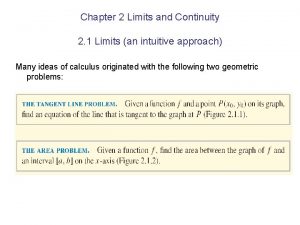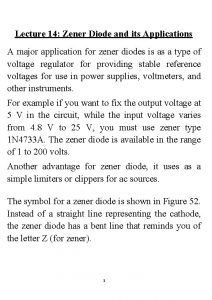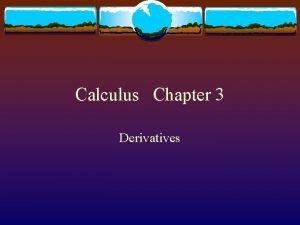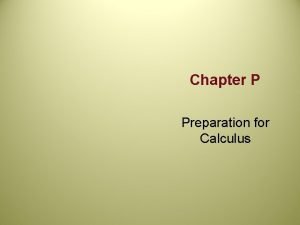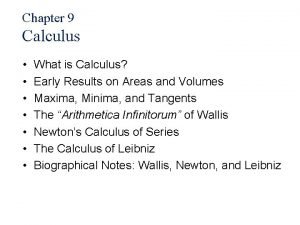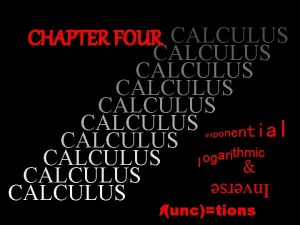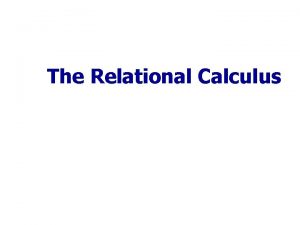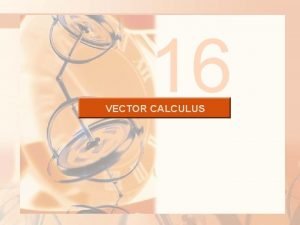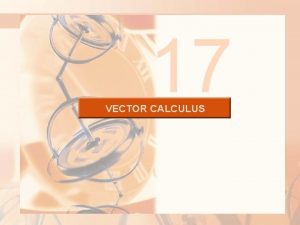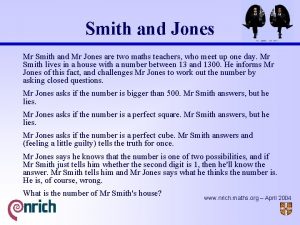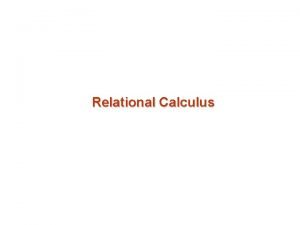Chapter 5 Jones Calculus and Its Application to



















- Slides: 19

Chapter 5 Jones Calculus and Its Application to Birefringent Optical Systems Lecture 1 Wave plates (retardation plates) are optical elements used to transform the polarization states of light. They are made from one or more pieces of birefringent crystals. • Let us consider a plate made of a uniaxial crystal with a thickness of l. Usually the plate is cut so that its optic axis lies in the plane of the plate surface. • For a normally incident light, the polarization directions of the two eigenwaves both lie in the surface of the plate, and are mutually orthogonal. One polarization direction coincides with the optic axis, with a refractive index ne. The other is perpendicular to the optic axis, with a refractive index no. • The polarization direction with the larger refractive index is called the slow axis, and the polarization direction with the smaller refractive index is called the fast axis, regardless of whether it is an ordinary light or an extraordinary light. The refractive indices will be designated as nf and ns, respectively. 1

In the frame of the slow and fast axes, or the s-f coordinate system, suppose the input light is linearly polarized with the field The phase difference (retardation or retardance) between the f and s polarization is then f f s s f l s 2

Half-wave plates and quarter-wave plates 1) A half-wave plate converts a linearly polarized light into another linearly polarized light, mirrored by the fast or slow axis. 2) A quarter-wave plate converts a linearly polarized light into a circularly polarized light, when the input polarization is 45° to the fast and slow axes. At other azimuth angles it converts a linearly polarized light into an elliptically polarized light oriented along the fast or slow axes. f s s Half-wave plate s Quarter-wave plate s s Quarter-wave plate f f f f s s s Quarter-wave plate 3

Zero-order and multiple-order wave plates A half-wave plate with a retardation of is called a zero-order half-wave plate. The thickness of the plate is This thickness is not easy to fabricate and not easy to handle. We can use a thickness of which is a multiple-order wave plate. The wavelength sensitivity of a half-wave plate is Therefore a multiple-order wave plate has a limited bandwidth. One technique to solve this problem is to make a compound zero-order wave plate from two plates, with their optic axes intercrossed. The difference in thickness between the two plates determines the overall retardation. Zero-order wave plates thus have broad bandwidths. 4

Reading: Achromatic wave plates: y (e) y (o) Estimation of l 1 and l 2 (e. g. , QWP): In the wavelength range considered, the phase retardation should be as close as possible to p/2 (minimum rms, or similar other criteria). Mg. F 2 Crystal Quartz x (o) x (e) l 1=603 mm, l 2=477 mm. Question: Why do we need two materials? For a normal compound zero-order wave plate (one material), l 1 -l 2 is fixed, thus is fixed. For achromatic wave plates (two materials), l 1 and l 2 can be chosen to minimize , which greatly expands the applicable bandwidth. 5

Lecture 2 Jones matrix 5. 1 Jones matrix formulation While it is not difficult to track the polarization of light passing through an individual wave plate or polarizer using elementary algebra, when there is a combination of several such optical elements, and a certain goal is aimed, the algebra involved can be complicated. Jones calculus is created to study the transformation of polarization using linear algebra, where the polarization of light is represented by a Jones vector, and the function of an optical element is represented by a 2× 2 matrix. A fixed lab coordinate system (instead of the principle axes of the crystal) is normally used. The azimuth angle of the retardation plate is defined as the angle from the lab x axis to the slow axis of the crystal. The light is propagating in the z direction. 6

Wave plates: Let us first derive the 2× 2 matrix for a wave plate. Suppose the input light has an arbitrary polarization state . At the surface of the plate this light need to be decomposed into the two eigenwaves, which is a transformation to the s-f coordinate system. The polarization state after the plate, in the s-f coordinates, is then Here is the phase retardation, and is the average phase change. is the Jones matrix for the wave plate expressed in its own principle s-f coordinate system. In the x-y coordinate system the polarization state after the plate is 7

The overall effect of the retardation plate is then The e-if factor can be dropped if we are not dealing with interference. Therefore a retardation plate is characterized by its phase retardation G and azimuth angle y , and is represented in the lab frame by Note that the transformation is unitary: W+W=1. It does not change the inner product between two Jones vectors. This is because a wave plate does not absorb light. Linear polarizers (analyzers): An ideal linear polarizer with its transmission axis on the x axis is For a linear polarizer oriented at an azimuth angle y, the Jones matrix is Particularly 8

Combination of wave plates and polarizers: For a series of wave plates and polarizers, we need to just multiply the Jones matrix of individual element in sequence. Wave plates examples: Half-wave plate: A half-wave plate with its slow axis oriented at y =45°. The input light is linearly polarized in the vertical direction: For a general azimuth angle y, a half-wave plate will rotate a horizontally or vertically polarized light by 2 y. A half-wave plate will change a left-handed circularly polarized light into a right-handed circularly polarized light, and vice versa, regardless of the azimuth angle of the plate. 9

Quarter-wave plate: A quarter wave plate with its slow axis oriented at y =45°. The input light is linearly polarized in the vertical direction: Our textbook is wrong here. If the input light is horizontally polarized, it will be changed into a right-handed circularly polarized light. 10

5. 2 Intensity transmission For a Jones vector , the corresponding electric field is The absolute intensity of the light is then . For convenience, if we only care the relative intensity of light in one medium (e. g. , air), the factor (1/2)ev is a constant and can be dropped. We therefore define the intensity of light as For a Jones matrix transformation , the intensity transmittance is then 11

Intensity transmission examples: A birefringent plate sandwiched between two parallel polarizers: Suppose the transmission axes of the polarizers are both vertical. The slow axis of the birefringent plate is oriented at 45° from the x axis. The plate introduces a phase retardation The Jones matrix is Let the incident light be unpolarized, with unit intensity. After the first polarizer, the Jones vector is The electric field of the final transmitted light is The intensity transmittance is 12

A birefringent plate sandwiched between two crossed polarizers: As above, but let the transmission axis of the final polarizer be horizontal. The electric field of the final transmitted light is The intensity transmittance is This is complementary to the case of parallel polarizers. In both cases the transmission is a sinusoidal function of wave number 1/l. 13

Lecture 3 Twisted nematic liquid crystals Twisted nematic liquid crystal displays (TNLCDs) are currently the most commonly used LCDs. The display panel consists of many liquid crystal cells sandwiched between crossed polarizers. Inside each cell the nematic liquid crystals are aligned so that the director of the first molecule is parallel to the transmission axis of the polarizer. Each next molecule is gradually twisted so that the director of the last molecule in the cell is parallel to the transmission axis of the analyzer. How does an LCD work? In the OFF-state the linearly polarized incident light is changed in the liquid crystal cell so that its polarization follows the twist of the liquid crystal molecules. The polarization is finally rotated to be parallel to the analyzer and light is therefore transmitted. In the ON-state an electric field is added across the liquid crystal cell. The directors of the liquid crystal molecules will tilt toward the electric field direction. In this way the actual birefringence experienced by the incident light will decrease. The cell appears gray or dark depending on the strength of the external electric field. 14

f Light propagation in twisted anisotropic media Jones matrix of a twisted nematic liquid crystal cell Assume the twist is linear. Let f be the total twist angle (clockwise) of the crystal. Let G be the total phase retardation when the molecules are not twisted. We divide the crystal into N small thin plates with equal thickness. In the principal coordinate system of the first molecule, i. e. , let its slow axis be the x-axis, and look toward the light source, the overall matrix of the small plates is m=1 is on the most right. 15

Chebyshev’s identity: For a unimodular (AD-BC=1) 2× 2 matrix, It can be easily proved by mathematical induction. The Jones matrix of the small plates is then 16

The Jones matrix of the twisted nematic liquid crystal cell is given by letting N approach infinity in the above equation. Adiabatic following: Now if the incident light is linearly polarized in the slow (or fast) axis of the first molecule, the polarization vector of the light inside the twisted crystal will follow the rotation of the slow (or fast) principal axis of the local molecules. 17

Twisted nematic liquid crystal with f=p/2: Transmittance of twisted nematic liquid crystal with f=p/2: 1. Between crossed polarizers. 2. Between parallel polarizers. States of twisted nematic liquid crystal with f=p/2: 1. OFF-state: G>>p, T=1 for crossed polarizers, T=0 for parallel polarizers. 2. Fully ON-state: G 0, T=0 for crossed polarizers, T=1 for parallel polarizers. 3. Gray-level state: G is controlled by external field so that the transmission is continuously varied. This is how the twisted nematic liquid crystal display works. 18

Only knowledge on nature gives you peace in mind. P. Q. W. 19
 Quarter wave plate jones matrix
Quarter wave plate jones matrix Chapter 5 elasticity and its application multiple choice
Chapter 5 elasticity and its application multiple choice Practical application of calculus
Practical application of calculus Limits
Limits Elastisitas dan penerapannya
Elastisitas dan penerapannya Equilibrum
Equilibrum Midpoint formula economics
Midpoint formula economics Zener diode and its application
Zener diode and its application Fundamental equation of fluid statics
Fundamental equation of fluid statics Emigree poem summary
Emigree poem summary Its halloween its halloween the moon is full and bright
Its halloween its halloween the moon is full and bright Calculus chapter 5 integrals
Calculus chapter 5 integrals Stewart
Stewart Ap calculus chapter 5
Ap calculus chapter 5 Precalculus honors chapter 1 test
Precalculus honors chapter 1 test Calculus chapter 3
Calculus chapter 3 Calculus chapter 12
Calculus chapter 12 Chapter p preparation for calculus
Chapter p preparation for calculus What is calculus for
What is calculus for When a train increases its velocity its momentum
When a train increases its velocity its momentum



